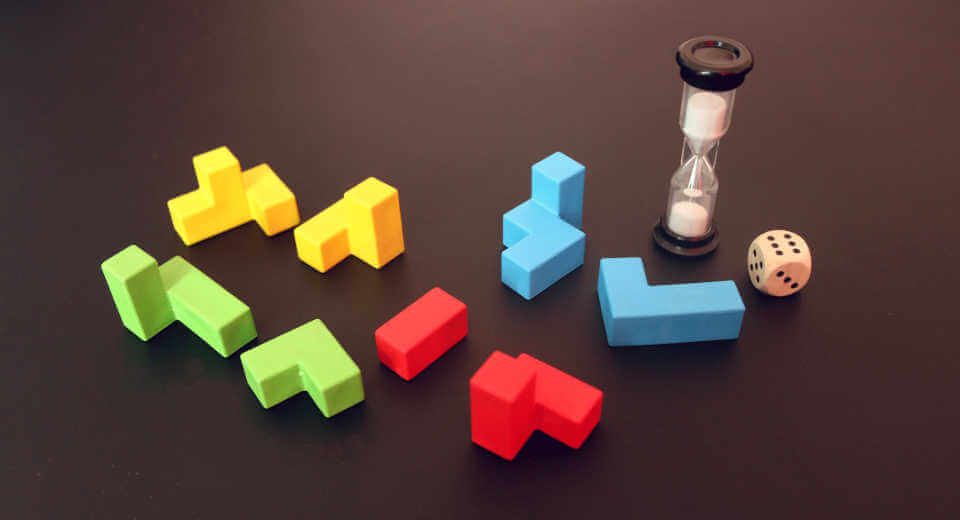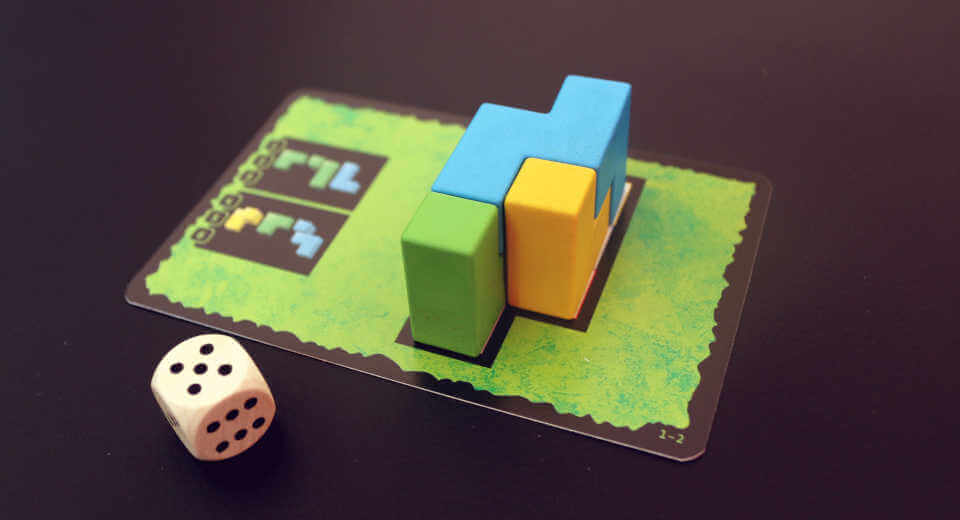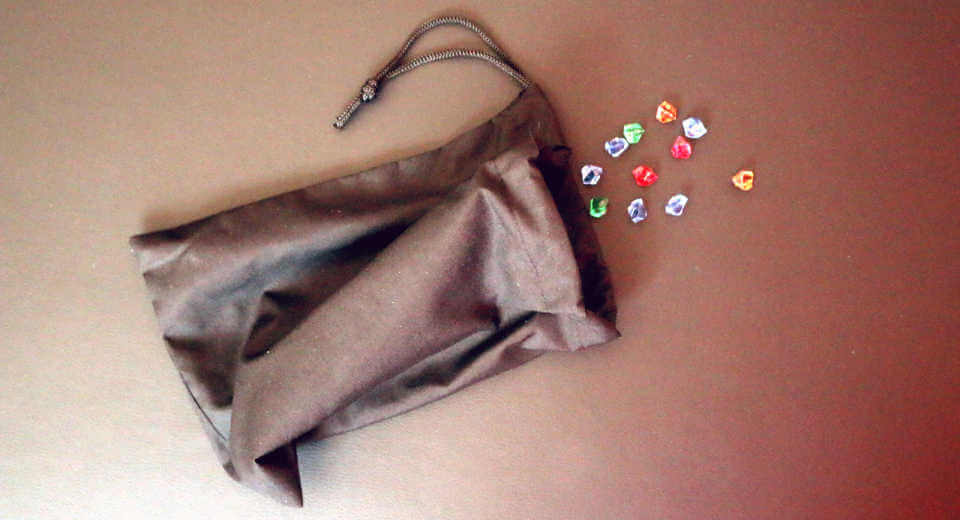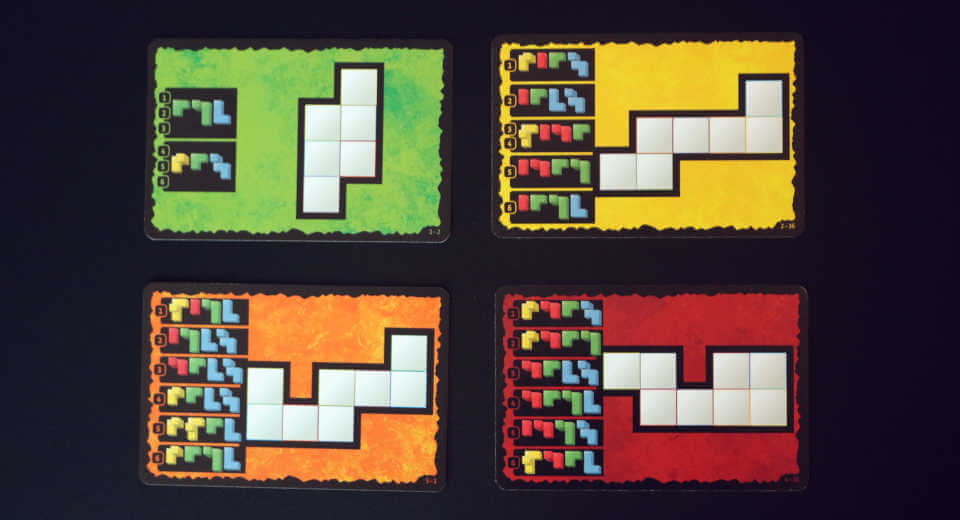The fast-paced game Ubongo is now also available in a three-dimensional version for families. Ubongo 3D Family is at least as addictive as the original and promotes spatial thinking in young and old alike!
“Ubongo!!!” – Hurrah, finally finished first again! I think and immediately take a sparkling sapphire from the display. As with all versions of Ubongo, Ubongo 3D Family is about puzzling for time. But not a classic puzzle with a motif and puzzle pieces, Ubongo is all about geometric shapes and spatial thinking!
In the classic form of Ubongo, which we have already presented here, this only played out on the surface. Besides numerous variants like Ubongo Solo, Ubongo as a duel, Ubongo as a card game or Bring-along game there was also already a Ubongo 3D edition. However, this only offered 2 difficulty levels and was a bit harder overall.
Ubongo 3D Family, on the other hand, offers 4 difficulty levels and easy access for children and adults. You can find out more in the detailed review below.
Note: Kosmos kindly sent us a free review copy of Ubongo 3D Family. However, this review is unpaid and reflects our independent opinion.
Ubongo 3D Family at a Glance
- Game type: Legespiel, Knobelspiel, Family game
- Age: from 8 years
- Players: 1 – 4 players
- Duration: approx. 25 minutes
- Publisher: Kosmos
- Game author: Grzegorz Rejchtman
- Publication year: 2019
- Game objective: In each round, use 8 three-dimensional laying pieces to lay a geometric shape with exactly 2 levels in 60 seconds, amassing the best collection of gems over 9 rounds.
How to Play Ubongo 3d Family
The basic idea is simple: for 9 rounds, each player receives a new laying board each round, representing a geometric figure of boxes. A dice roll determines which task number is played on this board. An hourglass is turned over and within one minute all players try as quickly as possible to fill the laying surface with the indicated 3D laying pieces in two stories.
Whoever finishes before the hourglass runs out shouts “Ubongo!” and gets to draw a gem from the bag. Whoever has the most valuable gem collection and thus the most points at the end is the winner.
Still not clear how it works? Then again in detail… 😉
Game Material and Preparation

The game material of Ubongo 3D Family consists of 72 double-printed laying boards in 4 difficulty levels, 4 times 8 laying pieces, 58 different coloured gems, a cloth bag, a dice and an hourglass.
At the beginning, each player takes their own set of 8 pieces. Note: a laying set does not consist of pieces of one colour, but of 2 differently shaped red, green, yellow and blue 3D pieces.
Now you decide which difficulty level you want to play. It is quite possible and intentional that players play different difficulty levels, depending on their ability, e.g. when adults play with children. If you are not sure, all start with green first. It’s not as easy as you think!
Each player should have a stack of 9 laying cards of their chosen level in front of them, but turned over. If the chosen level is green, for example, the yellow side faces up and vice versa.
Now sort out 9 sapphires (blue) and 9 ambers (brown) from the gems and lay two parallel rows with them. The remaining gems go into the black bag. Place the hourglass and dice in the middle between you.
Operation of a Round

At the beginning of each of the 9 game rounds, all players take the top card from their pile and place it in front of them with the side of their level now visible. The youngest player rolls the dice and another player turns the hourglass. Of course, you can alternate these tasks.
Once the hourglass is running, each player tries to solve the task indicated by the number of dice on their card. With a given selection of 3D pieces, he/she must now fill in two layers of the geometric figure. Nothing must overlap and no gaps must be left.
Example: The cube shows 5, which refers to the lower of two tasks on the green card #2. This shows exactly which 3 of the 8 laying pieces the player must now use. He quickly grabs them and now tries to put them together so that they fit as a compact two-storey block building on the pre-drawn figure.
As soon as you have solved your task, you call out loud “Ubongo!”. The first person to notice that the hourglass has run out immediately shouts “Stop!” and no more building is allowed. However, if none of the players has managed to solve their task when the hourglass runs out, the hourglass is turned over again. If no one has succeeded again after this second chance, the round is finally over.
In any case, at the end of a round, all the current laying cards are always put back into the box.
The Gems

But how does the evaluation work? That’s what the gems are for in Ubongo 3D Family. Basically, each player who has managed to solve his or her task within the hourglass time (approx. 1 minute) may reach into the black bag once and blindly draw a gem. However, these are worth different amounts:
- Ruby = 4 points
- Sapphire = 3 points
- Smaragd = 2 points
- Amber = 1 point
This adds a random element to the game so that victory does not depend on skill alone. Nevertheless, speed in solving is rewarded. For the first person who (correctly) shouted “Ubongo!” may, in addition to the blind grab in the bag, take a sapphire from the exposed row, the second additionally an amber.
Since the gems on display also act as a round counter, even if only one or even no one has made it in a round, you must take away the corresponding gems and then simply put them in the bag.
End of Game
After 9 rounds the game is over and everyone now evaluates their gems. Whoever has the most points wins. If more than one player has the same number of points, there is a tie-breaker. Each player involved in the tie receives a random laying board of their level. One of the players rolls the dice and off they go. You don’t need the hourglass this time, because the winner is now simply whoever solved their task first and shouted “Ubongo!”.
Solo Variant
You can also play Ubongo 3D Family alone. It is best to use a stopwatch or egg timer or a smartphone.
Now you can either set a fixed time, e.g. 5, 10, 15 or 20 minutes and see how many tasks you can complete within this time. Or you put a fixed number of tasks on the table and stop the time you need for them.
In both variants, you can train very well and try again and again to break your own records.
Evaluation and Conclusion

While we were already quite taken with the classic Ubongo, we enjoyed Ubongo 3D Family even more. And I have to admit: I have the ambition to become better and better at it, so that I now play it more often as a solo game to keep the grey cells fit and, above all, to train spatial thinking. 🙂
[review id=”74966″]
Pro and Con
First of all, it has to be said that the basic idea of all Ubongo versions is simply really good! – Putting geometric shapes together under time pressure to form other geometric shapes. So simple and so effective as a game idea!
With Ubongo 3D Family there is the additional difficulty that you now also have to think in the 3rd dimension. And that is not an insignificant difference, but it gives the game even more appeal.
I find it very good that there are even 4 different difficulty levels, because this way not only unequally skilled players (children and adults or simply differently gifted) can play against each other and it still remains exciting. Each player can also grow from level to level and record their own progress. By the way, I’m not so sure whether adults are always automatically better at this game than children, since the latter are often quite quick in the head and often have more practice with building blocks.
What Ubongo 3D Family does not offer, however, is real interaction. Sure, it’s important to be faster than the others, but in principle everyone plays for themselves. But there are no waiting times, because everyone’s turn always comes at the same time.
Whether you like the random principle that is built into the distribution of the gems is a matter of taste. The random reach into the bag, as well as the free choice of difficulty level, softens the importance of skill. This makes a lot of sense for a family game, because it increases the chance that everyone will win and minimises the risk of frustration, especially for children. And if you want, you can also come up with your own scoring system that does not contain any random element and depends purely on how quickly you solve the tasks.
For Whom Is Ubongo 3d Family Worthwhile?
The title already reveals the target group and it is indeed an ideal family game, but I have also played it in a purely adult group and everyone had fun. The only criterion is that you should enjoy puzzle games and especially spatial thinking. If you can’t do anything, you should rather play something else.
Conversely, however, anyone who is passionate about playing Tetris, solving Rubik’s Cube or even doing tricky 3D puzzles will love Ubongo 3D Family!
Conclusion
This family game is easy to learn, adaptable to different player levels thanks to different difficulty levels and, above all, really fun. In addition, Ubongo 3D Family is ideal for training spatial thinking – Tetris fans will be thrilled anyway!
At Greatime you can find many more family games like Gingerbread House board game or Isle of Skye. You can also browse activities with kids, friends or your partner!
If you like our website, we would be very happy if you like us on Facebook and Instagram!
*This article contains referral links. That means, if you buy a product through it, we get a small commission and you support us. This does not change the price.

![Ubongo 3d The Fast Paced Puzzle Game In 3d Review [Uber En="Ubongo*3D*Family*trains*the*spatial*thinking*of*children" De="Ubongo*3D*Family*schult*das*räumliche*Denken*der*Kinder"]](https://greatime.de/wp-content/uploads/2019/06/ubongo-3d-family-1.jpg)
![Uber En Quot Get To Know You Bingo With Questions And Free Templates Quot De Quot Kennenlern Bingo Mit Fragen Und Kostenlosen Vorlagen Quot [Uber En="Get*to*know*you*Bingo*with*questions*and*free*templates" De="Kennenlern*Bingo*mit*Fragen*und*kostenlosen*Vorlagen"]](https://greatime.de/wp-content/uploads/2021/12/get-to-know-you-bingo.jpg)
![Horrorfilm Trinkspiel 2 [Uber En="Horror*movie*drinking*games*for*fun*on*Halloween*or*anytime." De="Das*Horrorfilm-Trinkspiel*für*grauenhaften*guten*Spaß*an*Halloween*oder*auch*jederzeit."]](https://greatime.de/wp-content/uploads/2016/03/horrorfilm-trinkspiel-2.jpg)
![Quiz 2017 [Uber En="The*Quiz*2017*is*a*great*New*Year's*Eve*game*for*your*New*Year's*Eve*party." De="Das*Jahresquiz*2017*eignet*sich*super*als*Silvester-Spiel*für*deine*Silvesterparty"]](https://greatime.de/wp-content/uploads/2017/12/jahresquiz-2017.jpeg)